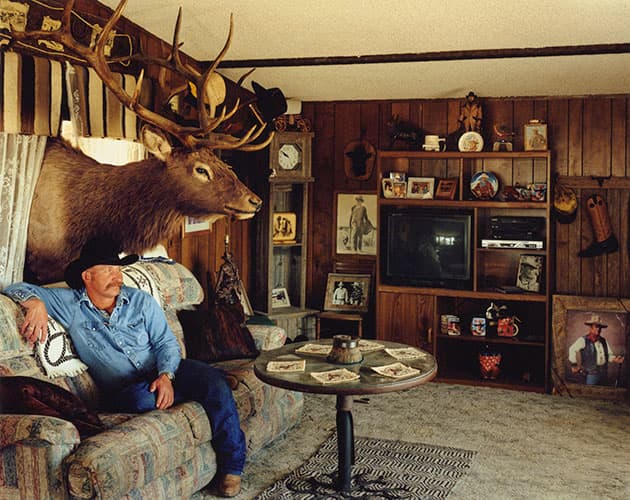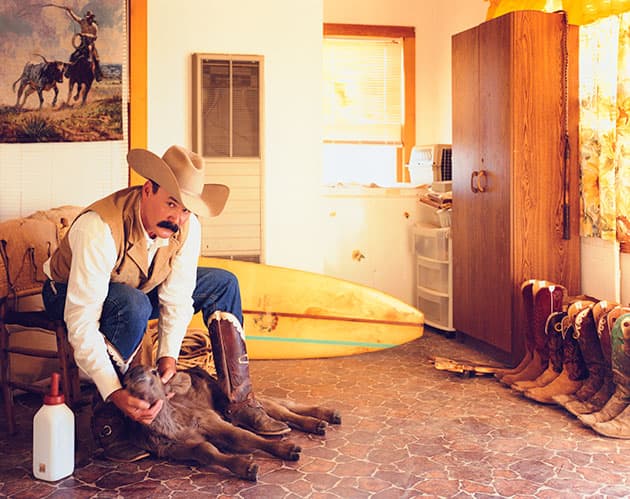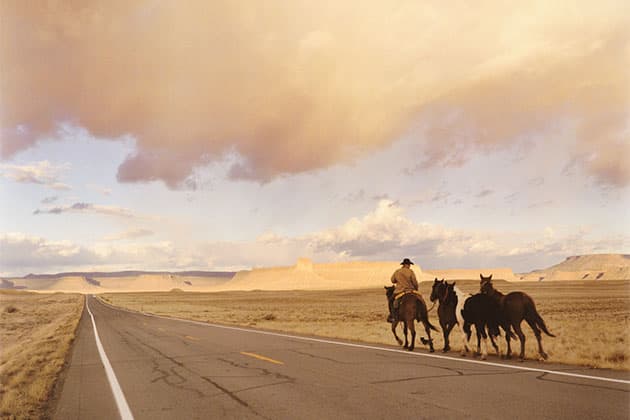‘I’ve never ridden a horse,’ says Jane Hilton, matter of factly. The framed portraits of John Wayne and Clint Eastwood stare out from the bookshelf. Jane was ten years old when she first straddled a horse on a wet week in Wales, as school trips often were. While her friend Lynn bolted away and others trotted triumphantly around, Jane’s horse, Jet, stood firm. ‘Give it a good hard kick,’ suggested an instructor. Jane obliged and Jet took off with speed. Jane’s body didn’t and involuntary back-flipped on to the ground leaving her severely winded. For this wanna be cowboy, it wasn’t a good equine introduction.

Allan Randolph, Gun Collector, Beulah, Colorado. Credit: Jane Hilton
Jane’s fascination with cowboy culture began wedged between her family on their suburban home counties sofa, watching Westerns Bonanza and The Virginian. It culminated over three decades later with her 2010 book (published by Schilt), Dead Eagle Trail. Looking out of the Farrow and Ball blue painted studio across a grotty, grey north London morning, Jane explains: ‘Whilst on a road trip in the United States, I was commissioned by The Times Magazine in 2006 to photograph a 17-year-old cowboy called Jeremiah Karsten. He had travelled 4,000 miles on horseback from his native Alaska to Mexico which took him two and a half years to complete. Immediately after, I met him in Cortez, Colorado, where he had returned to spend time with a young girl he had fallen in love with. He was then nineteen. I took a photograph in Shiprock, New Mexico, an evocative image of Jeremiah riding along the roadside: barriers and fencing made it difficult for him to go cross country. Wild horses trail behind him which he used to sell to local ranches after he had broken them in. The photograph re-introduced me to a love of landscape photography and Jeremiah introduced me to some inspiring old cowboys whose homes were over flowing with Western artefacts. I then set off on my own four-year pilgrimage criss-crossing the cowboy states of Nevada, Arizona, Utah, Texas, New Mexico and Wyoming to capture America’s 21st century cowboys. I’d always had a fascination with cowboy culture and the American dream, but this solidified it for me. I could have easily continued photographing this project forever.’ The photographs in Dead Eagle Trail ooze information: there are guns, hats, boots, skulls, crucifixes, spurs, living animals, stuffed animals, animal skins, horns and a surf board. And they’re chock-full of characters: there’s a Chuck, Ron, Bill, Ed, Bobby, Kim, Dave, Gary, Gave, Jake, Bud, Ted and Herman. The names are short and the portraits are sumptuous. The Wista 4×5 mahogany film camera with standard 90mm lens that took them, gorgeous.

Sharon’s Bar and Brothel. Credit: Jane Hilton
The Wista was also deployed to shoot Jane’s second book, Precious (Schilt 2013), a collection of intimate nude portraits of working girls in brothels across Nevada, the only state in America where prostitution is legal. ‘I’d never photographed a nude before and it wasn’t intentional,’ she says, handing me a rose pink mug of Sainsbury’s bought, Colombian blend coffee, along with a slightly soft ginger biscuit. ‘I could have photographed them at home but they would have looked like a housewife. Wearing their work clothes they would have looked like a prostitute. By photographing them nude in the brothels, you see the woman behind the facade.’ Many were uncomfortable taking off their clothes for the camera and very body conscious. On a tight budget, Jane was permitted to stay in some of the brothels. This contributed to her bond with the women, some of whom were initially reluctant to be photographed. Cassidy was one such woman. A tall, black girl in her mid-20s, Cassidy, at the age of six, witnessed the murder of her mother at the hands of her stepfather. She was working as a prostitute to earn money to build a half-way house for people who had nowhere to go. This dramatic and heartbreaking story is included at the back of the book along with other compelling, empowering and enlightening accounts from the working girls. The viewer has to hunt for the biographical information in order to work out who says what and match it to the portrait. The book gives the viewer an opportunity to leave behind any preconceptions.

Mackenzie, Kit Kat Ranch. Credit: Jane Hilton
Precious was unfinished business. Jane first discovered the brothels of Nevada in 1998. ‘I kept seeing these funny little signs along the road for Shady Lady and Moonlight Bunny Ranch. I had to find out what they were.’ What she did find was Madam Kitty’s Cathouse. After discussions with the proprietor, Jane was granted permission at first to photograph and then later to film in two locations. The BBC commissioned ten episodes of Love For Sale which was first broadcast in 2002. The in-at-the-deep-end baptism hasn’t deterred Jane. She is currently working on what she has been working on for the previous six years. The Last Lion Tamer is a film documenting the turmoil for Thomas Chipperfield and his family as they fight to save their 300-year way of existence. The legendary circus family have a rich history of caring for their legally licensed wild animals but society has changed. Indifference, antagonism, animal rights protestors, an increasingly hostile media and a proposed UK government ban on all wild animals performing at the circus has seen the Chipperfields rapidly slide from the Big Top. Jane flips up the laptop lid and plays the documentary trailer. ‘They call it a Sizzle in the industry now,’ she sighs. Breathtaking archive footage of attending royalty, performing tigers, elephants and a lion on the side of a car circling inside the Wall of Death, make way to modern and more mundane circus acts of a duck on a slide and cat through a hoop. The making of the documentary has exhausted Jane and her finances. She has already put thousands into it and needs tens of thousands more to finish it. Her own showdown with the financial ringmaster is imminent.

Jason Pelham, Cowboy and Surfer, Spade Ranch, Canadian, Texas. Credit: Jane Hilton
The Last Lion Tamer has taken its toll. ‘If I don’t get my fix of American culture I just don’t feel myself.’ It’s been over a year since she last went. Her beloved 1966 gold Ford Mustang with white hard top, bought for a fistful of dollars during a forced hiatus filming Love For Sale, waits for her in a Las Vegas garage – the V8 engine cold, racing pony emblem dulled. Before she can go, Jane is sorting through what she has done. A monograph is planned of her 30 years travelling around Nevada. She hands me contact sheets and scans for another proposed book, Forever Starts Now. ‘I photographed Vegas weddings and chapels throughout the 1990s. I’ve seen 120 couples wed and every which way to do it; on rollercoasters, roller-blades and in hot-air balloons. I’ve witnessed Star Trek fans marry at the space chapel and been a witness for couples at over a dozen weddings.’ Jane’s own wedding was a bit more traditional, walking down the aisle in Stoke Poges, dressed in an off-white halter-neck dress topped with a slightly sparkling Stetson hat – you can take the wannabe cowboy out of America…

Thomas Chipperfield, the last lion tamer. Credit: Jane Hilton
Jane, who has Hilton receptionists in a fluster when she checks-in at her namesake hotel, prefers to hear and record the stories of others than reveal in too much detail her own. The classically educated musician with a BA (Hons) in Music and Art from Lancaster University, with a penchant for French composers Debussy and Faure, gathers her cowboy boot key-ring into the pocket of her autumn leaf-coloured long coat, adjusts her Longhorn Steer jewel necklace and heads off to her appointment with the chiropractor – perhaps a legacy of that first horse, Jet.
Jane Hilton is a London-based photographer and videographer. She has been exploring themes around the American West for the past 25 years. She has been exhibited numerous times, and published several books. To see more of her images, visit www.janehilton.com







